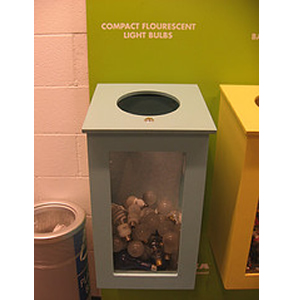
These days more and more homes and businesses are being lit by mercury-containing compact fluorescent lights (CFL). While they represent a much better alternative than traditional incandescent light bulbs and last up to 10 or 15 times longer than regular “Edison” bulbs, the cleanup process after a bulb break can be dangerous and complicated. These CFL bulbs contain mercury, which is harmful to people and the environment if they are not properly disposed.
Recycle Bulbs
The U.S. Environmental Protection Agency (EPA) encourages users of the bulbs to recycle them so that the materials, such as glass and metals can be reused, but also to keep mercury from contaminating the environment. The proper disposal of these bulbs can be a bit problematic so most municipalities have their own regulations concerning recycling of bulbs. Recycling locations can also be found at Earth911.com.
Cleanup If Bulb Breaks
Mercury emits toxic vapors that have serious health effects. To minimize exposure to mercury after a breakage, the EPA recommends clearing the room of any people and pets and let the room air out for at least fifteen minutes. To safely pick up the material, one should scoop-up the material with stiff paper or cardboard and then seal the broken pieces in a plastic bag or a canning jar. Then, the remaining fragments should be picked up using duct tape and placed in bags along with damp paper towels that should be used to clean the area of the breakage.
If the bulb breaks over a carpeted area, one should proceed the same way by picking up the broken pieces with tape and if vacuuming is necessary, carefully remove the vacuum bag and place that in along with the other materials in a plastic bag. Any clothing or bedding that came into contact with the physical contents of the broken CFL should be thrown away because it could contaminate the washing machine or water supply.
As worldwide energy sources are increasingly taxed by the day, the usage of CFLs is certainly a step in the right direction, but an even more environmentally-friendly alternative is poised to become a more significant part of everyday lighting life: the light emitting diode (LED). This lighting technology is already utilized in many everyday items such as mobile phones and laptops.
New Technology
LEDs were first developed over the course of the first half of the 20th century when it was discovered by a radio technician who found specific components (the diodes) in the radios would emit light when an electric current was applied to them. Nick Holonyak is credited as the inventor of the LED as we know it today. In his work for General Electric in 1962, he was the first to apply the technology to the visible light spectrum by producing the first practical LED. Later, Monsanto Co. and Hewlett Packard further developed the technology as it became more viable for use in consumer products such as calculators, radios, telephones, and wrist-watches.
While LEDs are far more efficient, as they produce more light per watt, the quality of light from LEDs has long been a hindrance in the development and the application of the technology. It is now improving and has scored a 92 on the Color Rendering Index, which measures the ability of a light source to reproduce colors of objects compared to natural light. This is comparable to the quality one would expect from a 60 watt “Edison” light bulb. State of the art LEDs, on the other hand, are now being widely developed that can rival the quality of the more established lighting options.
Another obstacle is the high initial costs that go into the implementation of LED lighting technology. In spite of the advances in design, LEDs remain too expensive for most consumers because of additional drive circuitry and power supplies needed to implement the technology successfully in the home. Despite the upfront cost, one can expect to save significant costs over the use of incandescent, halogen, and CFL lighting options because the maintenance of the LEDs is far cheaper. The lifespan of the LEDs is at least more than 10 times that of a normal light bulb. They are also very small and can be easily applied as lighting sources. LEDs are more hardy than incandescent and CFL bulbs because of their “solid state” design — they can’t be easily damaged by any external forces.
To prove that widespread conversion to LEDs can be achieved effectively, one only needs to look to the small town of Torraca in southwestern Italy. The first European municipality to be totally lit by LEDs, it spent 280,000 euros to completely replace its 700 traditional street lamps, lowering the town’s energy consumption by 70 percent. Appropriately dubbed the “LED city,” it stands in the foreground of this lighting revolution.
Significant Savings
With 22 percent of electricity consumption in the United States devoted to lighting, the U.S. Department of Energy expects that nearly $280 billion could be saved by 2028, including the widespread implementation of LED lighting. The government allows for tax rebates and subsidies, and many companies offer ways to convert businesses and homes to the new technology.

